Demonstrations
AspireRFID Middleware
Warehouse Packet Delivery (AITdev AspireRfid 3 Tier Use)
The objective of ASPIRE’s Warehouse ALE Demo is to provide a GUI of a warehouse Delivery Counter from which will be automatically be “fed” with RFID Tag data from the Filtering and collection server captured report. This way someone will be able to demonstrate a warehouse delivery scenario using only three tiers of the AspireRFID middleware (
Hardware Abstraction Layer,
Reader Core Proxy and
F&C Server).
For more information on how to download and run this demo you can go to the "
WarehousePacketDelivery(3 Tier Use)” at the "
AITdev Demos" page.
Warehouse Packet Delivery (AITdev AspireRFID 6 Tier Use) (See YouTube Video)
 See the Demo's Video
See the Demo's Video
The objective of ASPIRE’s Warehouse EPCIS Demo is to provide a Virtual Warehouse Management system GUI that supports receiving scenarios from a readpoint and will use the hole
AspireRFID Architecture. The tags that will pas throe the specific read point will be filtered from the
F&C Server and be send within a report to the
Business Event Generator engine. Then the BEG engine will translate them to event data taking in consideration the transaction defined at the master data and store them to the
EPCIS Repository. The Event data will be retrieved from the EPCIS repository with the help of the
Connector and send to the Warehouse Management System. This way someone will be able to demonstrate a warehouse delivery scenario using six tiers of the AspireRFID middleware (
Hardware Abstraction Layer,
Reader Core Proxy,
F&C Server,
Business Event Generator,
EPCIS Repository and the
Connector).
For more information on how to download and run this demo you can go to the "
WarehousePacketDelivery (6 Tier Use)” at the "
AITdev Demos" page.
RFID Suite
Object tracking
This demonstration presents the tracking of several objects. End users are alerted when objects are lost or stolen and when some pairing rules (driver licence with tractor model, carried object type and pallets, ...) are not satisfied.
This demonstration uses the RFID Suite. The documentation is available
here.
Under construction
Hardware Kit for the in-vitro demo (available on
http://shop.lego.com):
- 1 laptop
- 1 Lego® starter train set kit (5608 or 5609) + a set of bricks (5577)
- 1 or more Touchatag readers and a set of ISO14443 tags (such as Touchatag)
- 1 or more iBuddies (one per Touchatag reader)
For a more complex demo, a Lego® Mindstorms® NXT (
B8527 or
9841) can switch the tracks (
3775) and measures distance (and then train speed), noise level, light, …
The NXT communicates data using a bluetooth connection with the edge.
 video soon?
video soon?This demo was presented on the OW2 stand at JavaOne 2009.
The diaporama ...
Supply chain management
This demonstration extends the latter demonstration with shipping QoS criteria tracking (position (vertical), shock, temperature, light). Each tracked object is attached either to a RFID tag and to a wireless sensors.
Hardware Kit for the in-vitro demo:
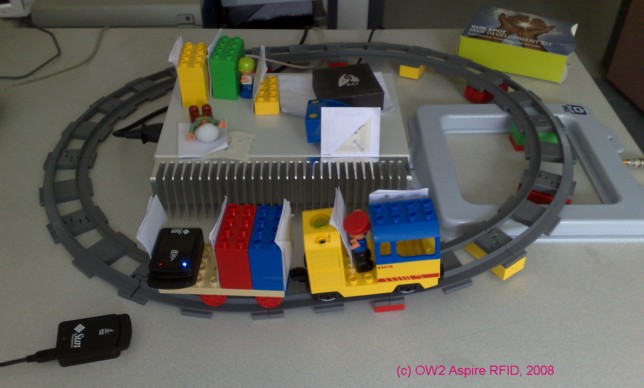
video (.mp4)
Sounding Balloon tracking
A
sounding balloon has been launched from l'IUT de Valence (
map) , France, the 24th of April 2009.
The balloon has flown for 3 hours (2 hours up, 1 hour down), up to 26500 meters (
87000 feet) high, and has landed 140 km (
87 miles) away (
map). KML track coming soon !
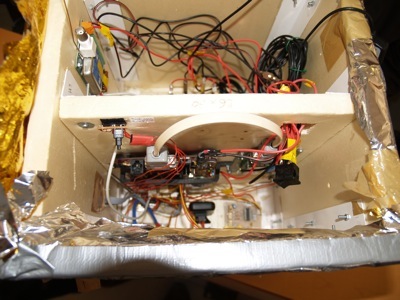
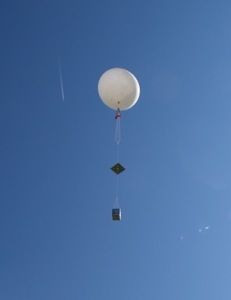
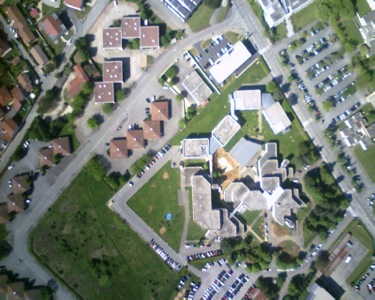
Collected data were:
- GPS position (latitude,longitude, altitude)
- internal and external temperatures
- pressure
- snapshots
The flight has been followed in real-time in a classroom, using Aspire RFID suite, by the 40 high school students that had worked on the sensors (
UBPE operation in french).
Screenshot of received events:

Screenshot of map tracking: (the four weird points on the upper right corner come from corrupted radio frames)

Screenshot of altitude graph:

Screenshot of pressure graph:

Flying part:
Ground part:
- Aspire Edge, running HTTPReader service, for collecting data received by radio
- Aspire EPCIS, for storing current track and measurements
- Aspire GWT Console for displaying current track and measurements
The full diaporama ...
The paper ...
The presentation ...
General RFID Demos
NFC Museum
This demonstration presents the usage of NFC phones to augment exhibits visits. The demonstration exists in 2 versions : one for NFC Java phones using NFC transponders and one for phones using the builtin camera to scan Data Matrix codes. A pre-release of the demo is running
here.
Under construction
Hardware Kit for the in-vitro demo:
- 1 laptop with a bluetooth dongle
- 1 Nokia 6131 NFC phone
- 1 Nabaztag (optional)
- 1 UPnP Renderer (optional)
- a set of ISO 14443 tags (remark: you can collect and reuse some transportation contactless tickets: most of them are MiFare Ultralight tags !).
 video soon?
video soon?
NFC Picking
This demonstration presents the usage of NFC phones to pick a subset of tagged objects.
Under construction
Hardware Kit for the in-vitro demo:
- 1 laptop with a bluetooth dongle
- 1 Nokia 6131 NFC phone
- a set of ISO 14443 tags (remark: you can collect and reuse some transportation contactless tickets: most of them are MiFare Ultralight tags !).
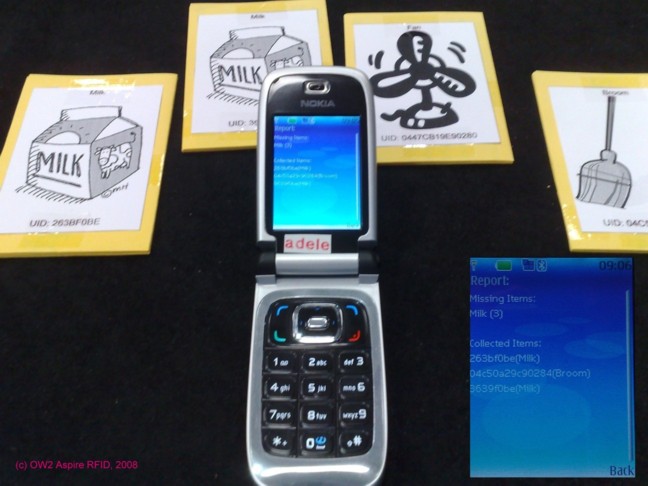 video soon?
video soon?Remark: we are looking for testers who own other NFC Java-phones (BenQ T80, Nokia 6212 NFC, Japanese Felica NFC phones, Twinlinx MyMax NFC/BT stickers ...).
The Patrol Man
This demonstration presents the usage of NFC phones in a patrol purpose.
The patrol man (aka the user) have to connect his phone to a bluetooth server which will send it a report specification file (ECSpec).
This file contains questionnaires representations paired with one or more tag UID or record type pattern.
Then, when the user touches a tag during his patrol, the corresponding questionnaire will be shown, and its answers are kept in memory.
At the end of the patrol, the user have to connect a bluetooth server to send a report XML file (ECReport).
Each questionnaire answers are grouped by the pattern which was recognized and brought the questionnaire up.
See the complete description here
Touch and Locate
This demonstration presents the usage of NFC phones and RFID tags to present locations and associated points of interest to the user.
This application handles two different record types :
- Location : Coordinates are stored in binary form
- URI : Coordinates are stored in text form as a bookmark (for example: http://loc/45.187778/5.726945)
The location tags MUST contain latitude and longitude information, they MAY contain altitude and bearing information.
All information are retrieved from Google Map, through the static map API, and the AJAX API for POI listing.
See the complete description here
Misc
Homemade "Privacy-Friendly" Wallet
Usage: protect your personal data against RFID sniffing
- passports and ids (Budapest declaration)
- contactless credit cards : some have accessible banking infos
- contactless transportation cards : some are not locked or have accessible personal information (MOBIB, BlackHat RFID topics...]
- ...
Hardware kit
- 1 wallet
- 1 outdoor rubber tape
- 1 piece of cooking aluminium foil
Remark : add several foils to be 100% RFID protected

 video soon?This demo was presented on the OW2 stand at JavaOne 2009. The diaporama ...
video soon?This demo was presented on the OW2 stand at JavaOne 2009. The diaporama ...
 video (.mp4)
video (.mp4)


 Collected data were:
Collected data were:
 Screenshot of map tracking: (the four weird points on the upper right corner come from corrupted radio frames)
Screenshot of map tracking: (the four weird points on the upper right corner come from corrupted radio frames) Screenshot of altitude graph:
Screenshot of altitude graph: Screenshot of pressure graph:
Screenshot of pressure graph: Flying part:
Flying part:
 video soon?
video soon?
 video soon?Remark: we are looking for testers who own other NFC Java-phones (BenQ T80, Nokia 6212 NFC, Japanese Felica NFC phones, Twinlinx MyMax NFC/BT stickers ...).
video soon?Remark: we are looking for testers who own other NFC Java-phones (BenQ T80, Nokia 6212 NFC, Japanese Felica NFC phones, Twinlinx MyMax NFC/BT stickers ...).


 PDF
PDF History
History













